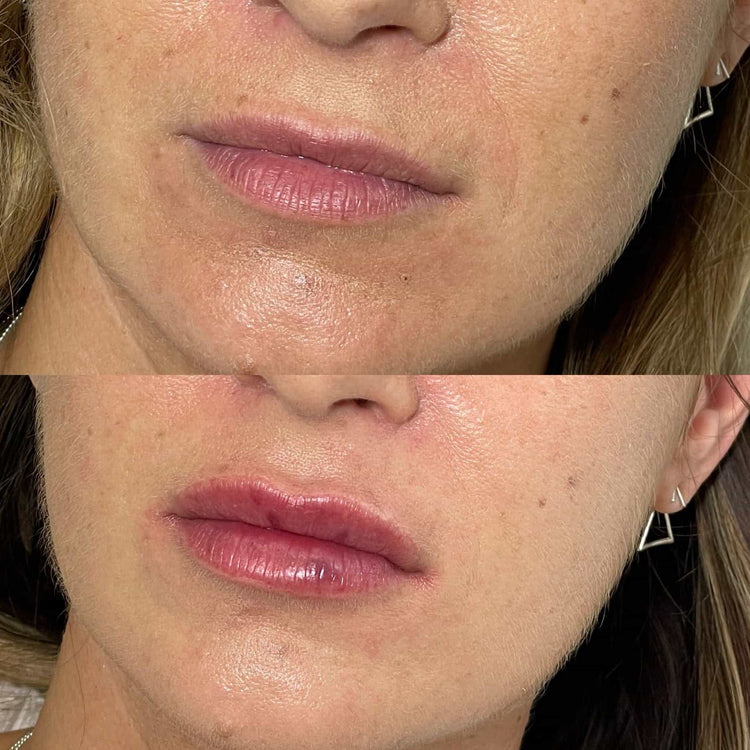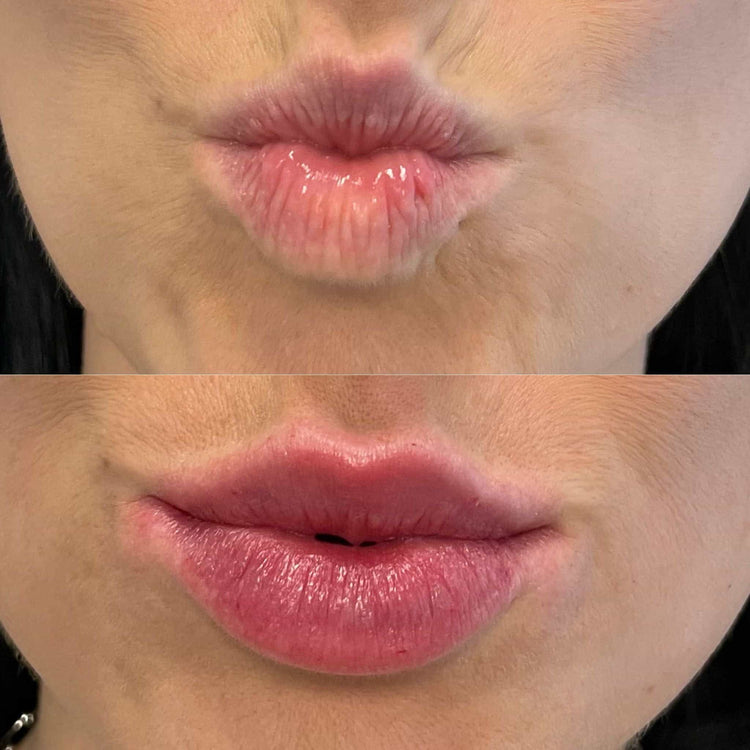Procedure for Dissolving Lip Fillers
Dissolving lip fillers is a procedure used to remove hyaluronic acid-based lip filler injections. It involves injecting an enzyme called hyaluronidase into the lips, which breaks down the hyaluronic acid, gradually softening and dispersing the filler over time. This process allows for the reversal of the effects of lip fillers, returning the lips to their original shape.
Consultation
The procedure for dissolving lip fillers in the UK typically begins with a consultation. During this consultation, a qualified medical practitioner will assess your individual needs and expectations. They will review your medical history, discuss any medications you are taking, and examine your current lip filler results.
Based on your specific situation, the practitioner will determine the appropriate amount of hyaluronidase required for dissolution. They will also explain the procedure in detail, outlining potential side effects and aftercare instructions.
Assessment
The process of dissolving lip fillers typically involves a series of injections of hyaluronidase directly into the areas where the filler is present. Hyaluronidase is an enzyme that specifically breaks down hyaluronic acid, the main component of most dermal fillers. The injections are carefully administered to ensure even distribution of the hyaluronidase throughout the affected area.
After the injection, the hyaluronic acid filler gradually dissolves over a period of days to weeks. During this time, you may experience some temporary swelling, redness, or bruising around the injection sites. These side effects are usually mild and resolve on their own within a few days.
It’s important to follow the aftercare instructions provided by your practitioner to minimize any potential complications and promote healing. This may include avoiding certain activities, applying cold compresses, or using prescribed medications.
Discussion and Decision-Making
Dissolving lip fillers is a decision that should be made carefully, considering both the benefits and potential risks involved. It’s crucial to have a thorough consultation with a qualified medical practitioner who can assess your individual needs and provide personalized advice.
During the consultation, it’s important to openly discuss your reasons for wanting to dissolve the fillers, your expectations for the outcome, and any concerns you may have. The practitioner will explain the procedure in detail, including the potential side effects, recovery time, and any limitations or risks associated with dissolving lip fillers.
Factors to consider when making a decision include the amount of filler injected, the type of filler used, your individual skin type and healing ability, and any underlying medical conditions. It’s also important to weigh the potential benefits against any perceived drawbacks, such as temporary swelling or bruising during the dissolution process.
Ultimately, the decision to dissolve lip fillers is a personal one that should be made in consultation with a qualified medical professional. A thorough evaluation and open communication will help ensure a safe and satisfactory outcome.
Treatment Process
Dissolving lip fillers is a procedure used to remove hyaluronic acid-based lip filler injections. It involves injecting an enzyme called hyaluronidase into the lips, which breaks down the hyaluronic acid, gradually softening and dispersing the filler over time. This process allows for the reversal of the effects of lip fillers, returning the lips to their original shape.
The procedure typically begins with a consultation where a qualified medical practitioner assesses your individual needs and expectations. They review your medical history, medications, and examine your current lip filler results. Based on this assessment, the practitioner determines the appropriate amount of hyaluronidase needed and explains the procedure in detail, outlining potential side effects and aftercare instructions.
The process involves injecting hyaluronidase directly into areas where the filler is present. Hyaluronidase breaks down hyaluronic acid, the main component of most dermal fillers. Injections are carefully administered to ensure even distribution throughout the affected area.

After the injection, the hyaluronic acid filler gradually dissolves over days to weeks. You may experience temporary swelling, redness, or bruising around the injection sites, which usually subside within a few days. It’s crucial to follow aftercare instructions provided by your practitioner to minimize potential complications and promote healing.
Dissolving lip fillers is a decision that requires careful consideration of both benefits and risks. Consulting with a qualified medical practitioner who can assess your individual needs and provide personalized advice is essential.
Injection of Hyaluronidase
Dissolving lip fillers in the UK involves injecting an enzyme called hyaluronidase to break down hyaluronic acid, the main component of most dermal fillers. This process gradually softens and disperses the filler, allowing for a reversal of the lip augmentation effects and returning lips to their original shape.
The procedure typically begins with a consultation where a qualified medical practitioner will assess your individual needs, medical history, current fillers, and expectations. They will determine the appropriate amount of hyaluronidase required based on the volume and type of filler used.
During the procedure, hyaluronidase is injected directly into areas where the filler is present. This ensures even distribution of the enzyme for optimal dissolution. The process usually takes around 15-30 minutes.
Following the injection, you may experience some temporary side effects like swelling, redness, or bruising at the injection sites. These typically subside within a few days with proper aftercare instructions provided by your practitioner.
The dissolution process takes several days to weeks for the hyaluronic acid filler to completely break down. Throughout this period, it’s important to avoid certain activities and follow the recommended aftercare guidelines to minimize any potential complications and ensure a smooth healing process.
Dissolving lip fillers is a decision that should be made carefully in consultation with a qualified medical professional who can assess your individual circumstances and provide personalized advice.
Aftercare Instructions
Dissolving lip fillers involves injecting an enzyme called hyaluronidase, which breaks down hyaluronic acid, the substance used in dermal fillers. This process gradually softens and disperses the filler, reversing its effects and restoring lips to their original shape.
The procedure begins with a consultation where a qualified practitioner assesses your needs, medical history, current lip fillers, and desired outcome. They determine the appropriate amount of hyaluronidase required based on the filler volume and type.
During the procedure, hyaluronidase is injected directly into areas where the filler is present. This ensures even distribution for optimal dissolution. The process typically takes 15-30 minutes.
You may experience temporary side effects like swelling, redness, or bruising at the injection sites, but these usually subside within a few days with proper aftercare instructions from your practitioner.
The dissolution process takes several days to weeks for the hyaluronic acid filler to completely break down. During this time, avoid certain activities and follow recommended aftercare guidelines to minimize complications and promote healing.
Dissolving lip fillers is a decision that should be carefully considered in consultation with a qualified medical professional who can assess your individual circumstances and provide personalized advice.
Risks and Side Effects
Dissolving lip fillers involves injecting an enzyme called hyaluronidase, which breaks down hyaluronic acid, the substance used in dermal fillers. This process gradually softens and disperses the filler, reversing its effects and restoring lips to their original shape.
The procedure begins with a consultation where a qualified practitioner assesses your needs, medical history, current lip fillers, and desired outcome. They determine the appropriate amount of hyaluronidase required based on the filler volume and type.
During the procedure, hyaluronidase is injected directly into areas where the filler is present. This ensures even distribution for optimal dissolution. You may experience temporary side effects like swelling, redness, or bruising at the injection sites, but these usually subside within a few days with proper aftercare instructions from your practitioner. The dissolution process takes several days to weeks for the hyaluronic acid filler to completely break down.
Dissolving lip fillers is a decision that should be carefully considered in consultation with a qualified medical professional who can assess your individual circumstances and provide personalized advice.
Bruising
Dissolving lip fillers involves injecting an enzyme called hyaluronidase, which breaks down hyaluronic acid, the substance used in dermal fillers. This process gradually softens and disperses the filler, reversing its effects and restoring lips to their original shape.
The procedure begins with a consultation where a qualified practitioner assesses your needs, medical history, current lip fillers, and desired outcome. They determine the appropriate amount of hyaluronidase required based on the filler volume and type.
During the procedure, hyaluronidase is injected directly into areas where the filler is present. This ensures even distribution for optimal dissolution. You may experience temporary side effects like swelling, redness, or bruising at the injection sites, but these usually subside within a few days with proper aftercare instructions from your practitioner.
The dissolution process takes several days to weeks for the hyaluronic acid filler to completely break down.
Bruising is a common side effect of dissolving lip fillers. It occurs when blood vessels near the injection sites are damaged, causing blood to leak into the surrounding tissues.
Most bruising resolves on its own within a few days, but it can take up to two weeks in some cases. Applying cold compresses or taking over-the-counter pain relievers may help reduce swelling and discomfort.
Dissolving lip fillers is a procedure where an enzyme called hyaluronidase breaks down hyaluronic acid, the main component of most dermal fillers. This allows for the reversal of lip augmentation effects, returning the lips to their original shape.
The process involves injecting hyaluronidase directly into areas where filler is present. During this procedure, you may experience some temporary side effects like swelling, redness, or bruising, which are generally mild and subside within a few days.
Bruising after dissolving lip fillers can occur due to the injection process potentially causing small blood vessels to rupture. This bleeding beneath the skin leads to discoloration.
Swelling
Dissolving lip fillers is a procedure where an enzyme called hyaluronidase breaks down hyaluronic acid, the main component of most dermal fillers. This allows for the reversal of lip augmentation effects, returning the lips to their original shape.
- Consultation: A qualified medical practitioner will assess your needs, medical history, current lip fillers, and desired outcome. They determine the appropriate amount of hyaluronidase required based on the filler volume and type.
- Procedure: Hyaluronidase is injected directly into areas where filler is present to ensure even distribution for optimal dissolution. You may experience temporary side effects like swelling, redness, or bruising at the injection sites, which are generally mild and subside within a few days.
- Dissolution Process: The hyaluronic acid filler gradually dissolves over several days to weeks as hyaluronidase breaks it down.
Infection
Dissolving lip fillers is a procedure used to remove hyaluronic acid-based lip filler injections. It involves injecting an enzyme called hyaluronidase into the lips, which breaks down the hyaluronic acid, gradually softening and dispersing the filler over time. This process allows for the reversal of the effects of lip fillers, returning the lips to their original shape.

- Consultation: A qualified medical practitioner will assess your individual needs, medical history, medications, current lip filler results, and expectations.
- Procedure: Hyaluronidase is injected directly into areas where the filler is present to ensure even distribution for optimal dissolution. The process typically takes around 15-30 minutes.
- **Recovery:** You may experience temporary side effects like swelling, redness, or bruising at the injection sites, which usually subside within a few days with proper aftercare instructions provided by your practitioner.
Recovery Time
Dissolving lip fillers is a procedure that reverses the effects of hyaluronic acid-based lip augmentation. During this process, an enzyme called hyaluronidase is injected into the lips. Hyaluronidase breaks down the hyaluronic acid, causing the filler to gradually soften and disperse over time.
The entire process typically takes around 15-30 minutes. After the procedure, you may experience temporary side effects like swelling, redness, or bruising at the injection sites. These usually subside within a few days. The complete dissolution of the filler takes several days to weeks.
Recovery time after dissolving lip fillers is generally short. Most people can return to their normal activities within a day or two. However, it’s important to follow your practitioner’s aftercare instructions carefully to minimize potential complications and promote healing.
Things to Consider
Before deciding to dissolve lip fillers, it’s important to consider several factors. These include the amount of filler injected, the type of filler used, your individual skin type and healing ability, and any underlying medical conditions.
It’s also crucial to weigh the potential benefits against any perceived drawbacks, such as temporary swelling or bruising during the dissolution process.
Open communication with a qualified medical practitioner is essential. Discuss your reasons for wanting to dissolve the fillers, your expectations for the outcome, and any concerns you may have. This will help ensure a safe and satisfactory outcome.
Filler Type
Before making a decision about dissolving lip fillers, there are several important things to consider:
* **Amount and Type of Filler:** The amount of filler injected and the type used will influence the dissolution process and potential side effects.
* **Skin Type and Healing Ability:** Individual skin types and healing abilities vary, which can affect recovery time and potential complications.
* **Medical History:** Any underlying medical conditions or medications you take may need to be considered during the consultation.
* **Expectations and Reasons:** Clearly understand your reasons for dissolving the fillers and have realistic expectations about the outcome. Discuss any concerns you have with your practitioner.
* **Risks and Benefits:** Weigh the potential benefits of dissolving the fillers against any possible drawbacks, such as temporary swelling or bruising during the process.
Remember that open communication with a qualified medical professional is crucial to ensure a safe and satisfactory outcome. They can assess your individual circumstances, provide personalized advice, and answer any questions you may have.
Amount of Filler
When considering the dissolution of lip fillers, it’s essential to be mindful of the amount of filler present and the type used. The volume and composition directly impact the required dosage of hyaluronidase and the duration of the dissolution process.
Another crucial factor is understanding the potential for temporary side effects like swelling, redness, or bruising. While generally mild and short-lived, these can vary based on individual factors such as skin type and healing ability. Open communication with a qualified medical practitioner is paramount to ensuring a safe and satisfactory outcome.
Time Since Injection
The amount of time it takes for lip fillers to dissolve varies depending on several factors, including the amount injected, the type of filler used, and individual healing processes.
Generally, the dissolution process begins immediately after the hyaluronidase injection, but full results may take several days to weeks.
Dissolving lip fillers is a multi-step procedure that involves injecting an enzyme called hyaluronidase into areas where filler has been previously placed.
The time it takes for the filler to completely dissolve varies depending on several factors, including:
- Volume of Filler: Larger amounts of filler require more time to dissolve.
- Type of Filler: Different types of hyaluronic acid fillers may have varying dissolution rates.
- Individual Metabolism and Healing: Each person’s body processes substances at different rates, influencing the speed of dissolution.
Most people notice a gradual softening and reduction in volume within a few days to a week. However, full dissolution can take several weeks for some individuals.
During this process, it is important to follow your practitioner’s aftercare instructions carefully to minimize any potential complications.
Individual Factors
Dissolving lip fillers involves injecting an enzyme called hyaluronidase, which breaks down hyaluronic acid, the substance used in dermal fillers. The process takes time as the body naturally reabsorbs the broken-down filler molecules.
Several factors can influence the duration of this process:
- Amount of filler: Larger volumes take longer to dissolve.
- Type of filler: Different hyaluronic acid types have varying degradation rates.
- Individual metabolism: Each person’s body processes substances at a different pace.
While you may notice initial softening within days, complete dissolution can take several weeks. It’s important to follow your practitioner’s post-procedure instructions for optimal results and minimize potential side effects.
- Is Baby Botox The Right Treatment For You In Surrey? - September 29, 2025
- Filler For Volume Loss In Walton-on-Thames, Surrey - September 28, 2025
- Downturned Smile Treatment Near Shirley, Surrey - September 26, 2025
